Model development - Fine Dust Concentration Prediction
Version 1.0.0, April 26th 2023
| Version | Date | Author | Amendments | Status |
|---|---|---|---|---|
| 1.0.0 | April 26th 2023 | Skyler Vermeer | Layout + basic setup (introduction etc) | Draft |
| 1.1.0 | xxxx | Skyler Vermeer | xxxx | Draft |
Introduction
In this document we will be developing, evaluating and iterating upon multiple models. We are doing this to see which model gives better results. Seeing as we want to predict Particulate Matter concentrations at a certain location at a certain time, a time-series model is a logical first approach. This would take into account seasonality and trends.
After exploring researches that created similar models and their approaches, the models we are going to explore are: ARIMA, ETS, PROPHET, SNAIVE and Seasonal ARIMA. In this document we will explore all of them, evaluating them and if they have potential, develop a final model that is fit for deployment based on them.
We will evaluate them based on how accurate they are, their RMSE and MAE, and how long they would take when deployed.
Chapter 1 - Setting up
In this chapter we will be setting up our project, importing relevant packages and retrieving and preparing the relevant data for modelling.
Before we do anything, we need to load in our standard packages, printing out their version so our experiments can be reproduced.
import sklearn as sk
import numpy as np
import matplotlib
import matplotlib.pyplot as plt
import seaborn as sns
import pandas as pd
import warnings
warnings.filterwarnings('ignore')
%matplotlib inline
print('scikit-learn version:', sk.__version__)
print('numpy version:', np.__version__)
print(np.__file__)
print('matplotlib version:', matplotlib.__version__)
print('seaborn version:', sns.__version__)
print('pandas version:', pd.__version__)
scikit-learn version: 1.1.2
numpy version: 1.23.0
C:\Users\micro\AppData\Roaming\Python\Python39\site-packages\numpy\__init__.py
matplotlib version: 3.6.2
seaborn version: 0.12.2
pandas version: 1.5.2
Now we have the relevant packages, it is time to get the data
df_measurements = pd.read_csv("csv_files/full_measurement.csv")
print(df_measurements.sample(10))
Date Time Location PM10 PM2.5 PM1
1704657 2020-10-25 08:09:59 536 3.11 0.82 0.49
5178180 2022-07-23 21:00:00 572 6.66 4.13 3.44
4112962 2022-11-25 22:40:00 562 25.73 17.23 12.05
813186 2022-05-18 22:20:00 528 28.15 20.42 17.96
1209868 2022-06-23 06:00:00 531 11.98 7.14 5.83
3771851 2023-05-02 23:20:00 558 9.14 5.80 4.39
1302747 2021-12-02 17:50:00 532 2.51 0.26 0.26
1739831 2021-06-28 08:30:01 536 22.17 20.31 18.62
1469092 2020-12-05 21:20:00 534 12.16 6.69 5.26
4204727 2022-06-20 02:40:00 563 26.03 7.56 5.01
We have already somewhat prepared the data, however seeing as we are going to be exploring a lot of options the further preparation of data will need to be prepared on a case by case basis.
Let’s import a few packages that we will need to use that aren’t part of our standard list.
from statsmodels.tsa.seasonal import seasonal_decompose
from statsmodels.tsa.exponential_smoothing.ets import ETSModel
from datetime import datetime
from math import sqrt, floor
from sklearn.metrics import mean_squared_error, mean_absolute_error, r2_score
from prophet import Prophet
from decimal import Decimal
from pandas.plotting import autocorrelation_plot
from statsmodels.tsa.arima.model import ARIMA
import itertools
import statsmodels.api as sm
from statsmodels.tsa.holtwinters import ExponentialSmoothing
from statsforecast import StatsForecast
from statsforecast.models import SeasonalNaive
Now let’s make a function for plotting the decomposed time series, as this is something that we will have to do multiple times.
def plot_decomposed_time(original, model_type, period_num, suptitle_text):
result = seasonal_decompose(original, model=model_type, period = period_num)
trend = result.trend
seasonal = result.seasonal
residual = result.resid
decomposed_combo = [['Original', original], ['Trend', trend], ['Cyclic', seasonal], ['Residual',residual]]
fig, axes = plt.subplots(4, 1, sharex=True, sharey=False)
for idx in range(len(axes)):
axes[idx].plot(decomposed_combo[idx][1])
axes[idx].title.set_text(decomposed_combo[idx][0])
fig.tight_layout(rect=[0, 0.03, 1, 0.95])
fig.autofmt_xdate()
fig.suptitle(suptitle_text)
fig.set_figheight(10)
fig.set_figwidth(15)
plt.ioff()
plt.close(fig)
return fig
Based on our research in the EDA, we know that every 10 minutes introduces a lot of noise, disguising the trends a lot. That is why we will be altering the seasonality to make it every 60 minutes, using the average.
measurements_by_datetime = df_measurements.copy()
measurements_by_datetime['Datetime'] = pd.to_datetime(measurements_by_datetime['Date'] + ' ' + measurements_by_datetime['Time'])
measurements_by_datetime = measurements_by_datetime.set_index('Datetime')
df_521_data = measurements_by_datetime.loc[measurements_by_datetime.Location == 521]
hourly_521_data = df_521_data.resample('60min').mean().ffill()
hourly_521_data = hourly_521_data.asfreq('60min')
hourly_521_data
| Location | PM10 | PM2.5 | PM1 | |
|---|---|---|---|---|
| Datetime | ||||
| 2021-01-21 13:00:00 | 521.0 | 20.935000 | 10.983333 | 7.190000 |
| 2021-01-21 14:00:00 | 521.0 | 21.180000 | 9.538333 | 6.596667 |
| 2021-01-21 15:00:00 | 521.0 | 18.338333 | 9.216667 | 6.063333 |
| 2021-01-21 16:00:00 | 521.0 | 16.801667 | 8.466667 | 5.746667 |
| 2021-01-21 17:00:00 | 521.0 | 12.163333 | 6.010000 | 4.270000 |
| ... | ... | ... | ... | ... |
| 2023-05-19 05:00:00 | 521.0 | 21.443333 | 12.723333 | 9.218333 |
| 2023-05-19 06:00:00 | 521.0 | 22.588333 | 12.730000 | 9.610000 |
| 2023-05-19 07:00:00 | 521.0 | 25.113333 | 13.068333 | 9.831667 |
| 2023-05-19 08:00:00 | 521.0 | 22.680000 | 13.041667 | 9.475000 |
| 2023-05-19 09:00:00 | 521.0 | 26.280000 | 11.330000 | 8.150000 |
20349 rows × 4 columns
Now we have all the basics for trying out some models so we don’t have to keep repeating it.
hour_weather_data_full = pd.read_csv("csv_files/hourdata_eindhoven_2021_16may2023.csv")
hour_weather_data_full
| Date | Hour | WindDir | WindSpeed_avg | PrecipationHour | Temp | |
|---|---|---|---|---|---|---|
| 0 | 20210101 | 1 | 290 | 10 | 0 | 20 |
| 1 | 20210101 | 2 | 250 | 10 | 0 | 18 |
| 2 | 20210101 | 3 | 220 | 10 | 0 | 11 |
| 3 | 20210101 | 4 | 270 | 20 | 0 | 10 |
| 4 | 20210101 | 5 | 250 | 20 | 0 | 3 |
| ... | ... | ... | ... | ... | ... | ... |
| 20779 | 20230516 | 20 | 330 | 40 | 0 | 105 |
| 20780 | 20230516 | 21 | 320 | 20 | 0 | 90 |
| 20781 | 20230516 | 22 | 300 | 20 | 0 | 78 |
| 20782 | 20230516 | 23 | 300 | 20 | 0 | 71 |
| 20783 | 20230516 | 24 | 290 | 20 | 0 | 67 |
20784 rows × 6 columns
weather_measurements_by_datetime_full = hour_weather_data_full.copy()
datetimes = []
for index in weather_measurements_by_datetime_full.index:
string_to_convert = str(weather_measurements_by_datetime_full['Date'][index]) + " " + str(weather_measurements_by_datetime_full['Hour'][index] - 1)
datetimes.append(datetime.strptime(string_to_convert, "%Y%m%d %H"))
weather_measurements_by_datetime_full['DateTime'] = datetimes
print(weather_measurements_by_datetime_full.tail())
Date Hour WindDir WindSpeed_avg PrecipationHour Temp \
20779 20230516 20 330 40 0 105
20780 20230516 21 320 20 0 90
20781 20230516 22 300 20 0 78
20782 20230516 23 300 20 0 71
20783 20230516 24 290 20 0 67
DateTime
20779 2023-05-16 19:00:00
20780 2023-05-16 20:00:00
20781 2023-05-16 21:00:00
20782 2023-05-16 22:00:00
20783 2023-05-16 23:00:00
full_measurement = pd.read_csv('csv_files/full_measurement.csv')
full_measurement['DateTime'] = pd.to_datetime(full_measurement['Date'] + ' ' + full_measurement['Time'])
measurement_df = full_measurement.set_index('DateTime', drop=True)
grouper = measurement_df.groupby([pd.Grouper(freq='1H'), 'Location']) # .mean().ffill().asfreq('1H')
# hourly_measurement_full.sample(20)
result = grouper.mean().ffill()
hourly_measurement_full = result.reset_index()
hourly_measurement_full
| DateTime | Location | PM10 | PM2.5 | PM1 | |
|---|---|---|---|---|---|
| 0 | 2019-04-18 11:00:00 | 574 | 20.190000 | 15.050000 | 13.930000 |
| 1 | 2019-04-18 11:00:00 | 575 | 19.540000 | 11.460000 | 9.900000 |
| 2 | 2019-04-18 12:00:00 | 574 | 19.470000 | 14.322000 | 13.376000 |
| 3 | 2019-04-18 12:00:00 | 575 | 18.830000 | 10.296000 | 9.004000 |
| 4 | 2019-04-18 13:00:00 | 574 | 14.772000 | 10.352000 | 9.628000 |
| ... | ... | ... | ... | ... | ... |
| 964167 | 2023-05-19 09:00:00 | 576 | 19.206667 | 6.463333 | 5.495000 |
| 964168 | 2023-05-19 09:00:00 | 577 | 12.033333 | 6.821667 | 4.931667 |
| 964169 | 2023-05-19 10:00:00 | 575 | 14.460000 | 8.080000 | 5.745000 |
| 964170 | 2023-05-19 10:00:00 | 576 | 15.602500 | 6.862500 | 5.937500 |
| 964171 | 2023-05-19 10:00:00 | 577 | 12.578333 | 6.605000 | 4.628333 |
964172 rows × 5 columns
combine_weather_measurements = hourly_measurement_full.copy()
combine_weather_measurements['WindDir'] = np.nan
combine_weather_measurements['WindSpeed_avg'] = np.nan
combine_weather_measurements['PrecipationHour'] = np.nan
combine_weather_measurements['Temp'] = np.nan
print(len(weather_measurements_by_datetime_full.index))
combine_weather_measurements_full = pd.DataFrame()
for index in weather_measurements_by_datetime_full.index:
relevant_data = combine_weather_measurements[combine_weather_measurements['DateTime'] == weather_measurements_by_datetime_full['DateTime'][index]].copy()
relevant_data['WindDir'] = weather_measurements_by_datetime_full['WindDir'][index]
relevant_data['WindSpeed_avg'] = weather_measurements_by_datetime_full['WindSpeed_avg'][index]
relevant_data['PrecipationHour'] = weather_measurements_by_datetime_full['PrecipationHour'][index]
relevant_data['Temp'] = weather_measurements_by_datetime_full['Temp'][index]
combine_weather_measurements_full = pd.concat([combine_weather_measurements_full, relevant_data])
20784
combine_weather_measurements_full
| DateTime | Location | PM10 | PM2.5 | PM1 | WindDir | WindSpeed_avg | PrecipationHour | Temp | |
|---|---|---|---|---|---|---|---|---|---|
| 69454 | 2021-01-01 00:00:00 | 522 | 60.440000 | 51.553333 | 40.851667 | 290 | 10 | 0 | 20 |
| 69455 | 2021-01-01 00:00:00 | 524 | 51.945000 | 44.296667 | 21.755000 | 290 | 10 | 0 | 20 |
| 69456 | 2021-01-01 00:00:00 | 526 | 67.430000 | 60.678333 | 38.430000 | 290 | 10 | 0 | 20 |
| 69457 | 2021-01-01 00:00:00 | 527 | 70.378333 | 62.808333 | 39.130000 | 290 | 10 | 0 | 20 |
| 69458 | 2021-01-01 00:00:00 | 529 | 56.486667 | 51.555000 | 30.910000 | 290 | 10 | 0 | 20 |
| ... | ... | ... | ... | ... | ... | ... | ... | ... | ... |
| 961572 | 2023-05-16 23:00:00 | 572 | 14.198333 | 8.448333 | 5.388333 | 290 | 20 | 0 | 67 |
| 961573 | 2023-05-16 23:00:00 | 574 | 10.563333 | 4.800000 | 2.753333 | 290 | 20 | 0 | 67 |
| 961574 | 2023-05-16 23:00:00 | 575 | 10.540000 | 7.101667 | 4.821667 | 290 | 20 | 0 | 67 |
| 961575 | 2023-05-16 23:00:00 | 576 | 16.710000 | 5.246667 | 4.116667 | 290 | 20 | 0 | 67 |
| 961576 | 2023-05-16 23:00:00 | 577 | 9.560000 | 6.486667 | 4.405000 | 290 | 20 | 0 | 67 |
892123 rows × 9 columns
combine_weather_measurements_full.to_csv('csv_files/hour_combined_data_eindhoven_2021_16may2023.csv', index=False)
useable_data = pd.read_csv('csv_files/hour_combined_data_eindhoven_2021_16may2023.csv')
useable_data
| DateTime | Location | PM10 | PM2.5 | PM1 | WindDir | WindSpeed_avg | PrecipationHour | Temp | |
|---|---|---|---|---|---|---|---|---|---|
| 0 | 2021-01-01 00:00:00 | 522 | 60.440000 | 51.553333 | 40.851667 | 290 | 10 | 0 | 20 |
| 1 | 2021-01-01 00:00:00 | 524 | 51.945000 | 44.296667 | 21.755000 | 290 | 10 | 0 | 20 |
| 2 | 2021-01-01 00:00:00 | 526 | 67.430000 | 60.678333 | 38.430000 | 290 | 10 | 0 | 20 |
| 3 | 2021-01-01 00:00:00 | 527 | 70.378333 | 62.808333 | 39.130000 | 290 | 10 | 0 | 20 |
| 4 | 2021-01-01 00:00:00 | 529 | 56.486667 | 51.555000 | 30.910000 | 290 | 10 | 0 | 20 |
| ... | ... | ... | ... | ... | ... | ... | ... | ... | ... |
| 892118 | 2023-05-16 23:00:00 | 572 | 14.198333 | 8.448333 | 5.388333 | 290 | 20 | 0 | 67 |
| 892119 | 2023-05-16 23:00:00 | 574 | 10.563333 | 4.800000 | 2.753333 | 290 | 20 | 0 | 67 |
| 892120 | 2023-05-16 23:00:00 | 575 | 10.540000 | 7.101667 | 4.821667 | 290 | 20 | 0 | 67 |
| 892121 | 2023-05-16 23:00:00 | 576 | 16.710000 | 5.246667 | 4.116667 | 290 | 20 | 0 | 67 |
| 892122 | 2023-05-16 23:00:00 | 577 | 9.560000 | 6.486667 | 4.405000 | 290 | 20 | 0 | 67 |
892123 rows × 9 columns
Chapter 2 - ARIMA
In this chapter we are going to be seeing whether ARIMA (AutoRegressive Integrated Moving Average) might be an option for this project. To do this we are going to be looking at the results of a basic model, if there are any factors that would drastically improve in a non-basic model, and in the chapter Evaluation we are going to looking at if with this knowledge and some experimenting this model is the one to continue developing.
First we need to create a basic model and use it to predict our PM values. We want it to be location based, as the location has a drastic influence on the values, and have a different prediction for each PM value.
Let’s start with getting the hourly PM10 values. We want a train and test set, let’s try splitting in 90% training and 10% testing data for now.
arima_PM10_X = hourly_521_data.PM10
# size = int(len(arima_PM10_X) * 0.9)
arima_train, arima_test = arima_PM10_X[0:-12], arima_PM10_X[-12:]
history = [x for x in arima_train]
predictions = list()
len(arima_test)
12
Now let’s predict for the items in the test set what ARIMA thinks the value is.
model = ARIMA(history, order=(6,1,1))
model_fit = model.fit()
output = model_fit.forecast(len(arima_test))
print(output)
# for t in range(len(arima_test)):
# model = ARIMA(history, order=(6,1,1))
# model_fit = model.fit()
# output = model_fit.forecast()
# yhat = output[0]
# predictions.append(yhat)
# obs = arima_test[t]
# history.append(obs)
# print(t)
[24.50263313 24.64901739 24.72725562 24.70783426 24.65342629 24.61453263
24.58566049 24.56195447 24.54244349 24.52567607 24.51070663 24.49724354]
Now let’s see what the difference between our prediction and the actual values is.
test_dates = hourly_521_data.index[-12:len(arima_PM10_X)].strftime('%Y-%m-%d').tolist()
arima_test_values = []
for item in arima_test:
arima_test_values.append(item)
pred_real_comparison = {'dates':test_dates, 'true':arima_test_values, 'pred':output}
prc_df = pd.DataFrame(pred_real_comparison)
fig, ax = plt.subplots()
ax.plot(prc_df.true)
ax.plot(prc_df.pred,color='red')
# ax.set_xticks([0. ,2., 4., 6., 8., 10., 12., 14.])
ax.set_xticklabels(prc_df.dates[::2], rotation=90)
fig.suptitle("Difference between Arima model predictions and actual PM10")
plt.xlabel("Date")
plt.ylabel("PM10 (μg/m³)")
plt.show()
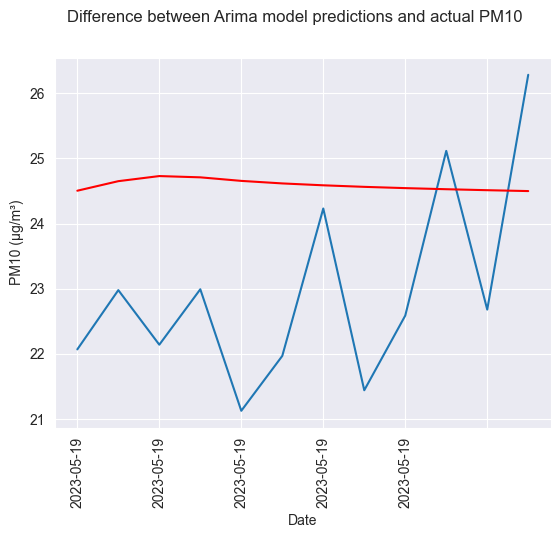
OBSERVATIONS
predictions = pred_real_comparison['pred']
predictions = predictions.tolist()
rmse = sqrt(mean_squared_error(arima_test, predictions))
print('Test RMSE: %.3f' % rmse)
mae = mean_absolute_error(arima_test, predictions)
print('MAE: %.3f' % mae)
r2_train = r2_score(prc_df.true, prc_df.pred)
print('R2 score: {}'.format(r2_train))
Test RMSE: 2.204
MAE: 2.017
R2 score: -1.27875243625301
OBSERVATIONS
Chapter 3 - ETS
In this chapter we are going to be seeing whether ETS (Exponential Smoothing) might be an option for this project. To do this we are going to be looking at the results of a basic model, if there are any aspects that would drastically improve the model later, and in the chapter Evaluation we are going to looking at if with this knowledge and some experimenting we can improve this model.
First we need to prepare the data we want to use. We are going to be using the location 521 data with 60min frequency again, to start.
ets_df = hourly_521_data.PM10
Now let’s take a look at the data when it is decomposed. Let’s start with the trends.
final = seasonal_decompose(ets_df,model='multiplicative')
final.trend.plot()
<AxesSubplot: xlabel='Datetime'>
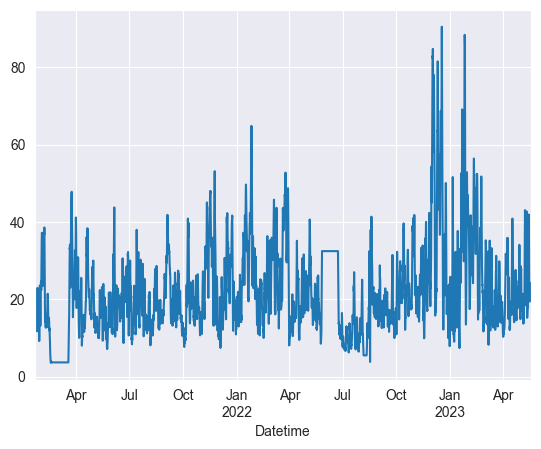
It’s useful to zoom in on the seasonality, as in a timeframe that spans multiple years, every hour produces a lot of data. Let’s use the first 100 for now.
final.seasonal[:100].plot()
plt.title("Multiplicative ETS decomposition Seasonality", fontsize=15)
plt.show()
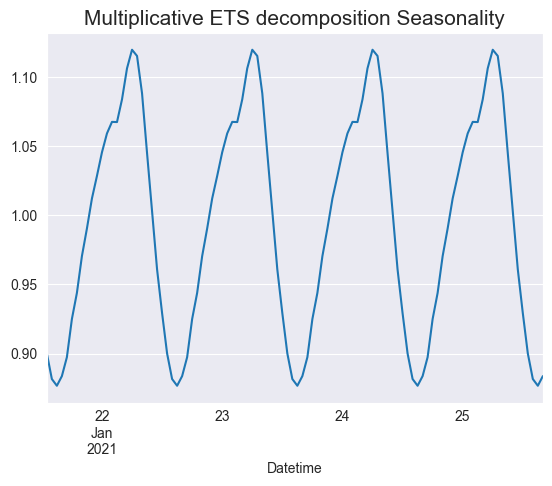
Now let’s show it all together.
final_decomposed = plot_decomposed_time(ets_df, 'multiplicative', 20, 'Decomposed plotting of average PM10 at location 521 with a 1H average per item')
final_decomposed
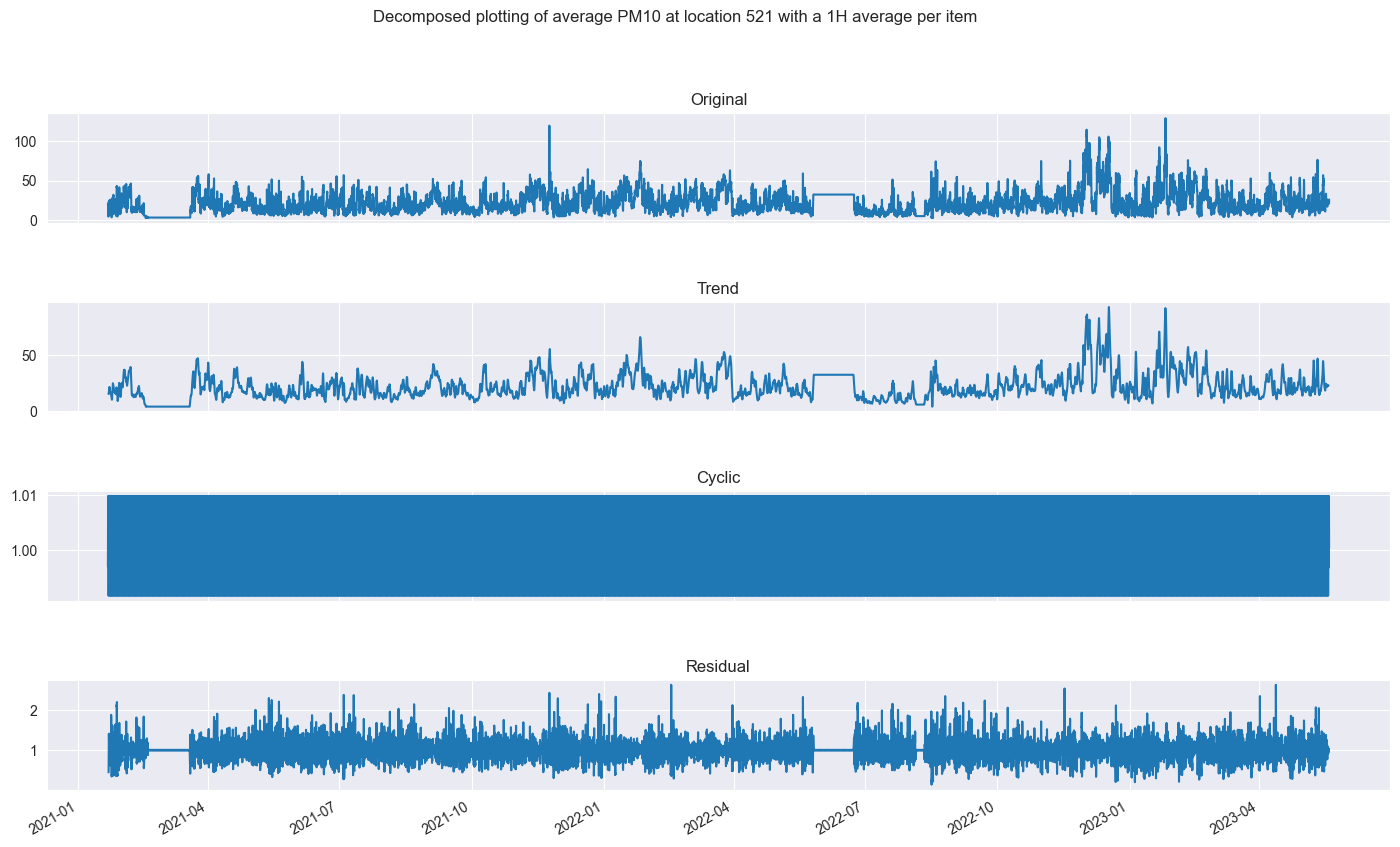
The next goal is to create a training and testing dataset. We can play a bit with the train and test difference later, for now we will take 90% and 10% again. We will also plot the datapoints of the training and test set.
ets_train = ets_df[0:-12]
ets_test= ets_df[-12:]
print("\n Training data start at \n")
print (ets_train[ets_train.index == ets_train.index.min()],['Date','PM10'])
print("\n Training data ends at \n")
print (ets_train[ets_train.index == ets_train.index.max()],['Date','PM10'])
print("\n Test data start at \n")
print (ets_test[ets_test.index == ets_test.index.min()],['Date','PM10'])
print("\n Test data ends at \n")
print (ets_test[ets_test.index == ets_test.index.max()],['Date','PM10'])
plt.scatter(ets_train.index, ets_train, label = 'Train')
plt.scatter(ets_test.index, ets_test, label = 'Test')
plt.legend(loc = 'best')
plt.title('Original data after split')
plt.show()
Training data start at
Datetime
2021-01-21 13:00:00 20.935
Freq: 60T, Name: PM10, dtype: float64 ['Date', 'PM10']
Training data ends at
Datetime
2023-05-18 21:00:00 23.788333
Freq: 60T, Name: PM10, dtype: float64 ['Date', 'PM10']
Test data start at
Datetime
2023-05-18 22:00:00 22.07
Freq: 60T, Name: PM10, dtype: float64 ['Date', 'PM10']
Test data ends at
Datetime
2023-05-19 09:00:00 26.28
Freq: 60T, Name: PM10, dtype: float64 ['Date', 'PM10']
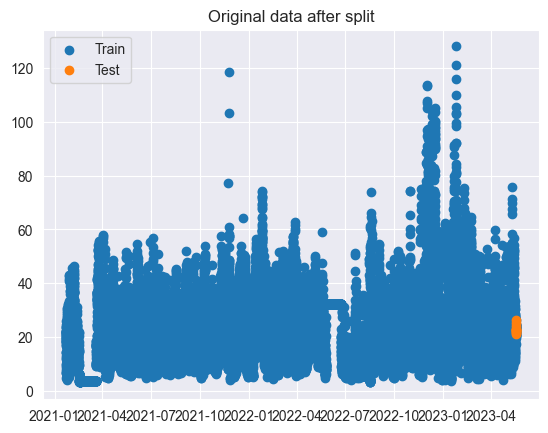
Now let’s see which combination of additive and multiplicative trend and seasonality calculation provides us with the best model.
warnings.filterwarnings("ignore")
trends = seasonals = ['add', 'mul', 'additive', 'multiplicative']
for trend in trends:
for seasonal in seasonals:
model = ExponentialSmoothing(ets_train, trend=trend, seasonal=seasonal, seasonal_periods=12).fit()
print('Trend: {} Seasonal: {} - AIC:{}'.format(trend, seasonal, model.aic))
Trend: add Seasonal: add - AIC:51584.38578673731
Trend: add Seasonal: mul - AIC:51703.90055441872
Trend: add Seasonal: additive - AIC:51584.38578673731
Trend: add Seasonal: multiplicative - AIC:51703.90055441872
Trend: mul Seasonal: add - AIC:53051.08022200621
Trend: mul Seasonal: mul - AIC:53350.007462004534
Trend: mul Seasonal: additive - AIC:53051.08022200621
Trend: mul Seasonal: multiplicative - AIC:53350.007462004534
Trend: additive Seasonal: add - AIC:51584.38578673731
Trend: additive Seasonal: mul - AIC:51703.90055441872
Trend: additive Seasonal: additive - AIC:51584.38578673731
Trend: additive Seasonal: multiplicative - AIC:51703.90055441872
Trend: multiplicative Seasonal: add - AIC:53051.08022200621
Trend: multiplicative Seasonal: mul - AIC:53350.007462004534
Trend: multiplicative Seasonal: additive - AIC:53051.08022200621
Trend: multiplicative Seasonal: multiplicative - AIC:53350.007462004534
The best AIC score would be the lowest possible, and it would be XXXX and XXXX trend. We can now create a model using this.
print(ets_test)
Datetime
2023-05-18 22:00:00 22.070000
2023-05-18 23:00:00 22.978333
2023-05-19 00:00:00 22.141667
2023-05-19 01:00:00 22.991667
2023-05-19 02:00:00 21.128333
2023-05-19 03:00:00 21.970000
2023-05-19 04:00:00 24.230000
2023-05-19 05:00:00 21.443333
2023-05-19 06:00:00 22.588333
2023-05-19 07:00:00 25.113333
2023-05-19 08:00:00 22.680000
2023-05-19 09:00:00 26.280000
Freq: 60T, Name: PM10, dtype: float64
model = ExponentialSmoothing(ets_train, trend='add', seasonal='add', seasonal_periods=24).fit()
ets_test.plot()
prediction = model.forecast(len(ets_test))
prediction.plot(label="Prediction")
# model.forecast(len(ets_test)).plot(label = 'Prediction')
plt.title("PM10 per 60 minutes", fontsize=15)
plt.xlabel('Date Time combo per 60 minutes')
plt.ylabel('PM10 ((μg/m³))')
plt.legend()
plt.show()
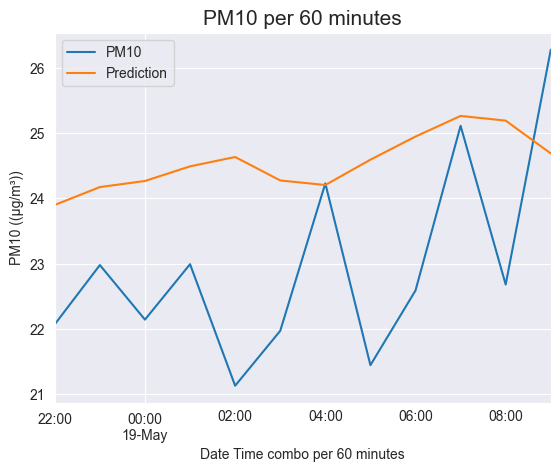
OBSERVATION
Let’s calculate the RMSE, MAE, and R2 score so we can compare it to the other models later.
y_true = ets_test.values
y_pred = model.forecast(len(ets_test))
mae = mean_absolute_error(y_true, y_pred)
rmse = sqrt(mean_squared_error(y_true, y_pred))
r2_train = r2_score(y_true, y_pred)
print('MAE: %.3f' % mae)
print('RMSE: %.3f' % rmse)
print('R2 score: {}'.format(r2_train))
MAE: 1.855
RMSE: 2.112
R2 score: -1.092018206614978
Chapter 4 - PROPHET
In this chapter we are going to be seeing whether PROPHET might be an option for this project. To do this we are going to be looking at the results of a basic model, looking at whether we know already adjustments that would significantly improve the performance, and in the chapter Evaluation we are going to looking at if with this knowledge and some experimenting we can improve this model.
First we need to prepare the data that we are going to use for this model. Prophet requires you to have your date as ds and your target as y.
# prophet_df = hourly_521_data.copy()
prophet_df = df_521_data.copy()
prophet_df = prophet_df['PM10']
# prophet_df['ds'] = prophet_df.index.values
# prophet_df['ds'] = pd.to_datetime(prophet_df['Date'] + ' ' + prophet_df['Time'])
prophet_df = prophet_df.reset_index(drop=False)
prophet_df.columns = ['ds','y']
Then we get the mean data of each date.
# prophet_df = prophet_df.groupby('ds').mean('y').reset_index()
Now we have the data to use, we will create a training and test dataset.
num_entries = prophet_df['ds'].count()
num_test_entries = -72
prophet_train = prophet_df.drop(prophet_df.iloc[num_test_entries:].index)
prophet_test = prophet_df[num_test_entries:]
It is time to create our basic model. One of the perks of Prophet is that you can easily add the holidays of the country you choose.
model = Prophet(yearly_seasonality=True, daily_seasonality=True, weekly_seasonality=True)
model.add_country_holidays(country_name='NL')
model.fit(prophet_train)
model.train_holiday_names
14:03:16 - cmdstanpy - INFO - Chain [1] start processing
14:07:57 - cmdstanpy - INFO - Chain [1] done processing
0 Nieuwjaarsdag
1 Eerste paasdag
2 Goede Vrijdag
3 Tweede paasdag
4 Hemelvaart
5 Eerste Pinksterdag
6 Tweede Pinksterdag
7 Eerste Kerstdag
8 Tweede Kerstdag
9 Koningsdag
dtype: object
dates = prophet_test['ds']
future = pd.DataFrame(dates)
future.columns = ['ds']
Now we have the model, we can predict our ‘future’, with the test data.
prophecy = model.predict(future)
hypothesis = prophecy.copy()
hypothesis['yhat_middle'] = hypothesis['yhat_upper'] - hypothesis['yhat_lower']
Now let’s see what the metrics are.
prophet_true = prophet_test['y'].values
prophet_pred = hypothesis['yhat_middle'].values
mae = mean_absolute_error(prophet_true, prophet_pred)
print('MAE: %.3f' % mae)
rmse = sqrt(mean_squared_error(prophet_test['y'].values, prophecy['yhat'].values))
print('Test RMSE: %.3f' % rmse)
MAE: 6.230
Test RMSE: 3.342
And what it looks like visually.
sns.set(rc={'figure.figsize':(15,6)})
fig = sns.lineplot(data=prophet_test, x='ds', y ='y', color='black')
sns.lineplot(data=hypothesis, x='ds', y ='yhat', color='green')
fig.set(title="PM10", xlabel="Time", ylabel="ug/m3")
plt.xticks(rotation=90)
plt.show()
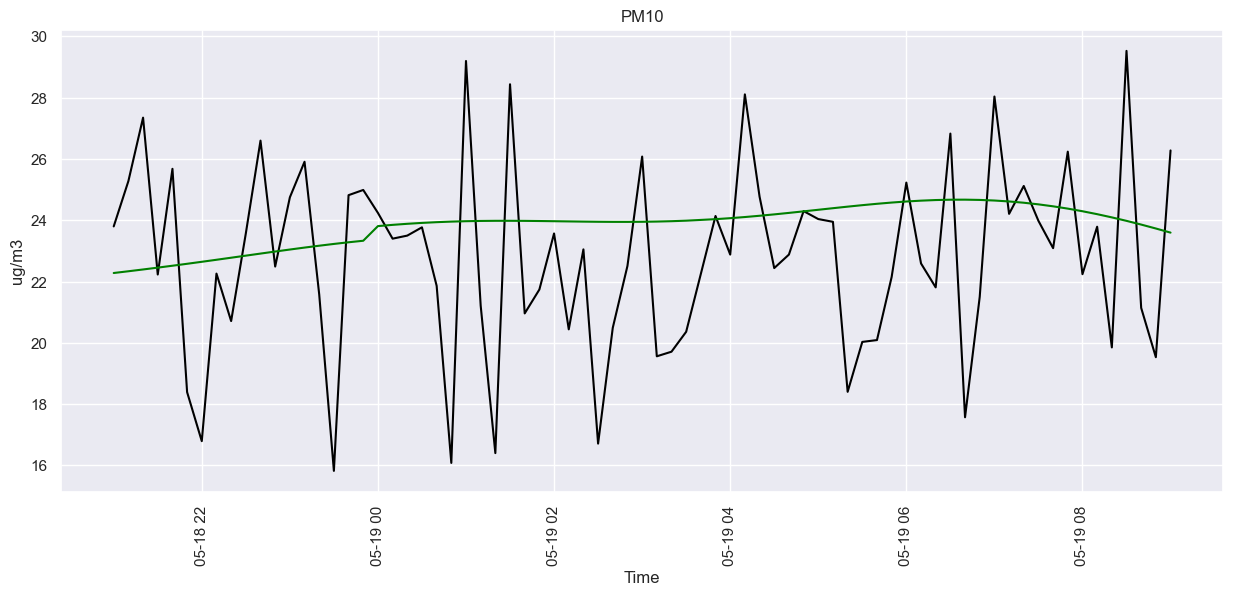
prophet_data = combine_weather_measurements_full[combine_weather_measurements_full['Location'] == 521].copy()
prophet_data = prophet_data.rename(columns={'DateTime':'ds', 'PM10': 'y'})
prophet_data
| ds | Location | y | PM2.5 | PM1 | WindDir | WindSpeed_avg | PrecipationHour | Temp | |
|---|---|---|---|---|---|---|---|---|---|
| 81916 | 2021-01-21 13:00:00 | 521 | 20.935000 | 10.983333 | 7.190000 | 210 | 90 | 0 | 84 |
| 81952 | 2021-01-21 14:00:00 | 521 | 21.180000 | 9.538333 | 6.596667 | 200 | 90 | 0 | 81 |
| 81988 | 2021-01-21 15:00:00 | 521 | 18.338333 | 9.216667 | 6.063333 | 200 | 70 | 0 | 82 |
| 82024 | 2021-01-21 16:00:00 | 521 | 16.801667 | 8.466667 | 5.746667 | 200 | 60 | 0 | 81 |
| 82060 | 2021-01-21 17:00:00 | 521 | 12.163333 | 6.010000 | 4.270000 | 190 | 60 | 2 | 62 |
| ... | ... | ... | ... | ... | ... | ... | ... | ... | ... |
| 961357 | 2023-05-16 19:00:00 | 521 | 17.615000 | 7.656667 | 5.011667 | 330 | 40 | 0 | 105 |
| 961401 | 2023-05-16 20:00:00 | 521 | 23.405000 | 8.698333 | 5.396667 | 320 | 20 | 0 | 90 |
| 961445 | 2023-05-16 21:00:00 | 521 | 22.431667 | 9.130000 | 5.641667 | 300 | 20 | 0 | 78 |
| 961489 | 2023-05-16 22:00:00 | 521 | 24.321667 | 10.835000 | 6.460000 | 300 | 20 | 0 | 71 |
| 961533 | 2023-05-16 23:00:00 | 521 | 24.141667 | 10.641667 | 6.711667 | 290 | 20 | 0 | 67 |
18732 rows × 9 columns
prophet_train = prophet_data[:-12][['ds', 'y', 'WindDir', 'WindSpeed_avg', 'PrecipationHour', 'Temp']]
prophet_test = prophet_data[-12:][['ds', 'y', 'WindDir', 'WindSpeed_avg', 'PrecipationHour', 'Temp']]
model = Prophet(yearly_seasonality=True, daily_seasonality=True, weekly_seasonality=True)
model.add_country_holidays(country_name='NL')
model.add_regressor('WindDir')
model.add_regressor('WindSpeed_avg')
model.add_regressor('PrecipationHour')
model.add_regressor('Temp')
model.fit(prophet_train)
14:08:01 - cmdstanpy - INFO - Chain [1] start processing
14:08:13 - cmdstanpy - INFO - Chain [1] done processing
<prophet.forecaster.Prophet at 0x1f0503526d0>
future = prophet_test.drop('y', axis=1)
prophecy = model.predict(future)
future
| ds | WindDir | WindSpeed_avg | PrecipationHour | Temp | |
|---|---|---|---|---|---|
| 961049 | 2023-05-16 12:00:00 | 330 | 60 | 0 | 140 |
| 961093 | 2023-05-16 13:00:00 | 330 | 50 | 0 | 134 |
| 961137 | 2023-05-16 14:00:00 | 350 | 40 | 0 | 135 |
| 961181 | 2023-05-16 15:00:00 | 330 | 40 | 0 | 141 |
| 961225 | 2023-05-16 16:00:00 | 320 | 50 | 0 | 141 |
| 961269 | 2023-05-16 17:00:00 | 320 | 40 | 0 | 129 |
| 961313 | 2023-05-16 18:00:00 | 310 | 40 | 0 | 117 |
| 961357 | 2023-05-16 19:00:00 | 330 | 40 | 0 | 105 |
| 961401 | 2023-05-16 20:00:00 | 320 | 20 | 0 | 90 |
| 961445 | 2023-05-16 21:00:00 | 300 | 20 | 0 | 78 |
| 961489 | 2023-05-16 22:00:00 | 300 | 20 | 0 | 71 |
| 961533 | 2023-05-16 23:00:00 | 290 | 20 | 0 | 67 |
prophet_true = prophet_test['y'].values
prophet_pred = prophecy['yhat'].values
mae = mean_absolute_error(prophet_true, prophet_pred)
print('MAE: %.3f' % mae)
rmse = sqrt(mean_squared_error(prophet_test['y'].values, prophecy['yhat'].values))
print('Test RMSE: %.3f' % rmse)
r2 = r2_score(prophet_test['y'].values, prophecy['yhat'].values)
print('Test r2: %.3f' % r2)
MAE: 2.452
Test RMSE: 3.040
Test r2: 0.588
sns.set(rc={'figure.figsize': (15, 6)})
fig = sns.lineplot(data=prophet_test, x='ds', y='y', color='black')
sns.lineplot(data=prophecy, x='ds', y='yhat', color='green')
fig.set(title="PM10", xlabel="Time", ylabel="ug/m3")
plt.xticks(rotation=90)
plt.show()
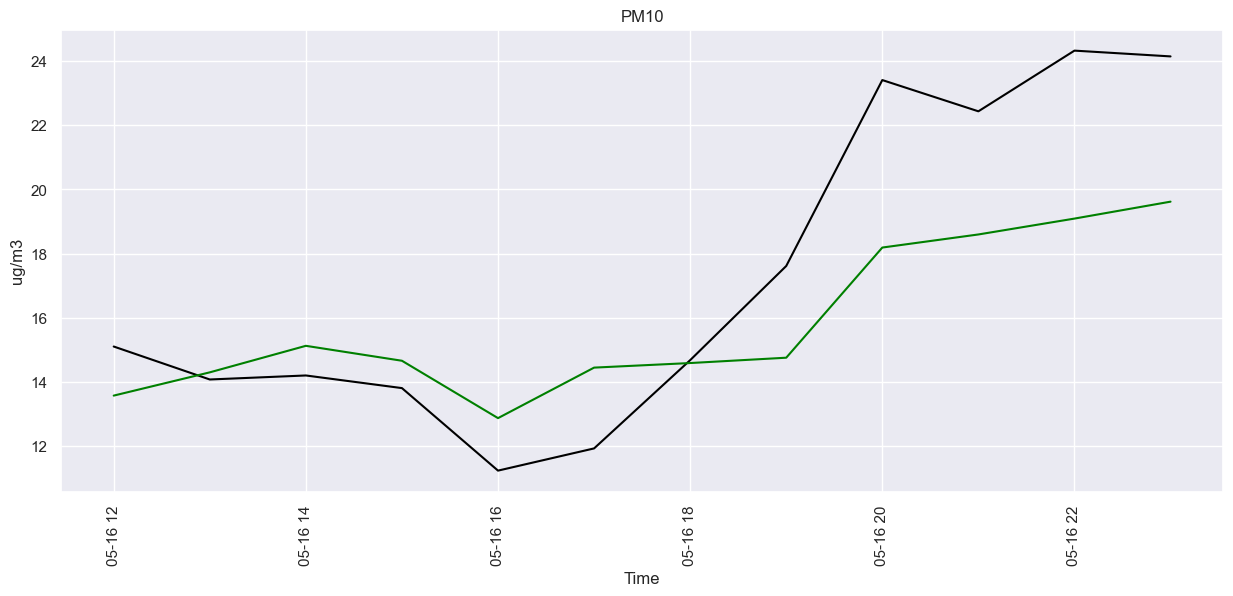
prophet_data = combine_weather_measurements_full[combine_weather_measurements_full['Location'] == 521].copy()
prophet_data = prophet_data.rename(columns={'DateTime':'ds', 'PM2.5': 'y'})
prophet_train = prophet_data[:-12][['ds', 'y', 'WindDir', 'WindSpeed_avg', 'PrecipationHour', 'Temp']]
prophet_test = prophet_data[-12:][['ds', 'y', 'WindDir', 'WindSpeed_avg', 'PrecipationHour', 'Temp']]
model = Prophet(yearly_seasonality=True, daily_seasonality=True, weekly_seasonality=True)
model.add_country_holidays(country_name='NL')
model.add_regressor('WindDir')
model.add_regressor('WindSpeed_avg')
model.add_regressor('PrecipationHour')
model.add_regressor('Temp')
model.fit(prophet_train)
future = prophet_test.drop('y', axis=1)
prophecy = model.predict(future)
prophet_true = prophet_test['y'].values
prophet_pred = prophecy['yhat'].values
mae = mean_absolute_error(prophet_true, prophet_pred)
print('MAE: %.3f' % mae)
rmse = sqrt(mean_squared_error(prophet_test['y'].values, prophecy['yhat'].values))
print('Test RMSE: %.3f' % rmse)
r2 = r2_score(prophet_test['y'].values, prophecy['yhat'].values)
print('Test r2: %.3f' % r2)
14:08:16 - cmdstanpy - INFO - Chain [1] start processing
14:08:28 - cmdstanpy - INFO - Chain [1] done processing
MAE: 1.216
Test RMSE: 1.374
Test r2: 0.469
sns.set(rc={'figure.figsize': (15, 6)})
fig = sns.lineplot(data=prophet_test, x='ds', y='y', color='black')
sns.lineplot(data=prophecy, x='ds', y='yhat', color='green')
fig.set(title="PM2.5", xlabel="Time", ylabel="ug/m3")
plt.xticks(rotation=90)
plt.show()
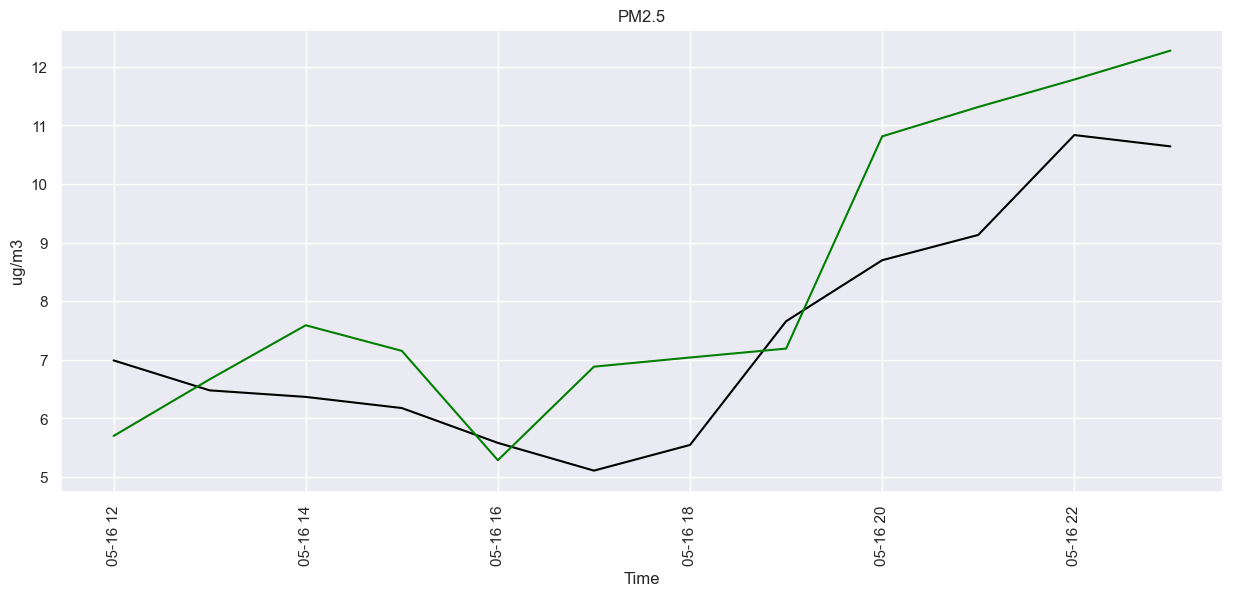
prophet_data = combine_weather_measurements_full[combine_weather_measurements_full['Location'] == 521].copy()
prophet_data = prophet_data.rename(columns={'DateTime':'ds', 'PM1': 'y'})
prophet_train = prophet_data[:-12][['ds', 'y', 'WindDir', 'WindSpeed_avg', 'PrecipationHour', 'Temp']]
prophet_test = prophet_data[-12:][['ds', 'y', 'WindDir', 'WindSpeed_avg', 'PrecipationHour', 'Temp']]
model = Prophet(yearly_seasonality=True, daily_seasonality=True, weekly_seasonality=True)
model.add_country_holidays(country_name='NL')
model.add_regressor('WindDir')
model.add_regressor('WindSpeed_avg')
model.add_regressor('PrecipationHour')
model.add_regressor('Temp')
model.fit(prophet_train)
future = prophet_test.drop('y', axis=1)
prophecy = model.predict(future)
prophet_true = prophet_test['y'].values
prophet_pred = prophecy['yhat'].values
mae = mean_absolute_error(prophet_true, prophet_pred)
print('MAE: %.3f' % mae)
rmse = sqrt(mean_squared_error(prophet_test['y'].values, prophecy['yhat'].values))
print('Test RMSE: %.3f' % rmse)
r2 = r2_score(prophet_test['y'].values, prophecy['yhat'].values)
print('Test r2: %.3f' % r2)
14:08:31 - cmdstanpy - INFO - Chain [1] start processing
14:08:41 - cmdstanpy - INFO - Chain [1] done processing
MAE: 1.294
Test RMSE: 1.504
Test r2: -1.171
sns.set(rc={'figure.figsize': (15, 6)})
fig = sns.lineplot(data=prophet_test, x='ds', y='y', color='black')
sns.lineplot(data=prophecy, x='ds', y='yhat', color='green')
fig.set(title="PM1", xlabel="Time", ylabel="ug/m3")
plt.xticks(rotation=90)
plt.show()
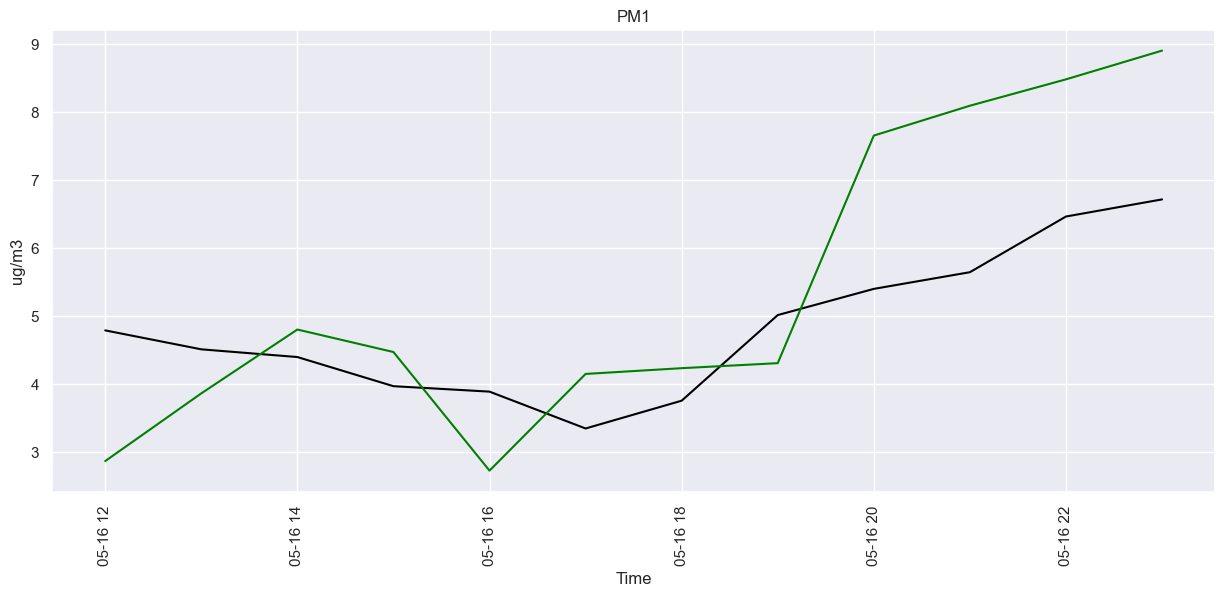
OBSERVATIONS
Chapter 5 - SNAIVE
In this chapter we are going to be seeing whether SNAIVE (Seasonal Naive) might be an option for this project. To do this we are going to be looking at the results of a basic model, and in the chapter Evaluation we are going to looking at if with this knowledge and some experimenting we can improve this model.
First we need to create a basic visualization of the time data.
print(hourly_521_data)
Location PM10 PM2.5 PM1
Datetime
2021-01-21 13:00:00 521.0 20.935000 10.983333 7.190000
2021-01-21 14:00:00 521.0 21.180000 9.538333 6.596667
2021-01-21 15:00:00 521.0 18.338333 9.216667 6.063333
2021-01-21 16:00:00 521.0 16.801667 8.466667 5.746667
2021-01-21 17:00:00 521.0 12.163333 6.010000 4.270000
... ... ... ... ...
2023-05-19 05:00:00 521.0 21.443333 12.723333 9.218333
2023-05-19 06:00:00 521.0 22.588333 12.730000 9.610000
2023-05-19 07:00:00 521.0 25.113333 13.068333 9.831667
2023-05-19 08:00:00 521.0 22.680000 13.041667 9.475000
2023-05-19 09:00:00 521.0 26.280000 11.330000 8.150000
[20349 rows x 4 columns]
series = hourly_521_data.copy()
series_PM10 = series['PM10']
len(series_PM10)
20349
Now we have the data to plot, we want to visualize the different aspects of the time series. Let’s grab a snapshot of 1000 entries near the end.
fig_mean_total = plot_decomposed_time(series_PM10[17000:18000], 'additive', 20, 'Decomposed plotting of average PM10 2019-2022')
fig_mean_total
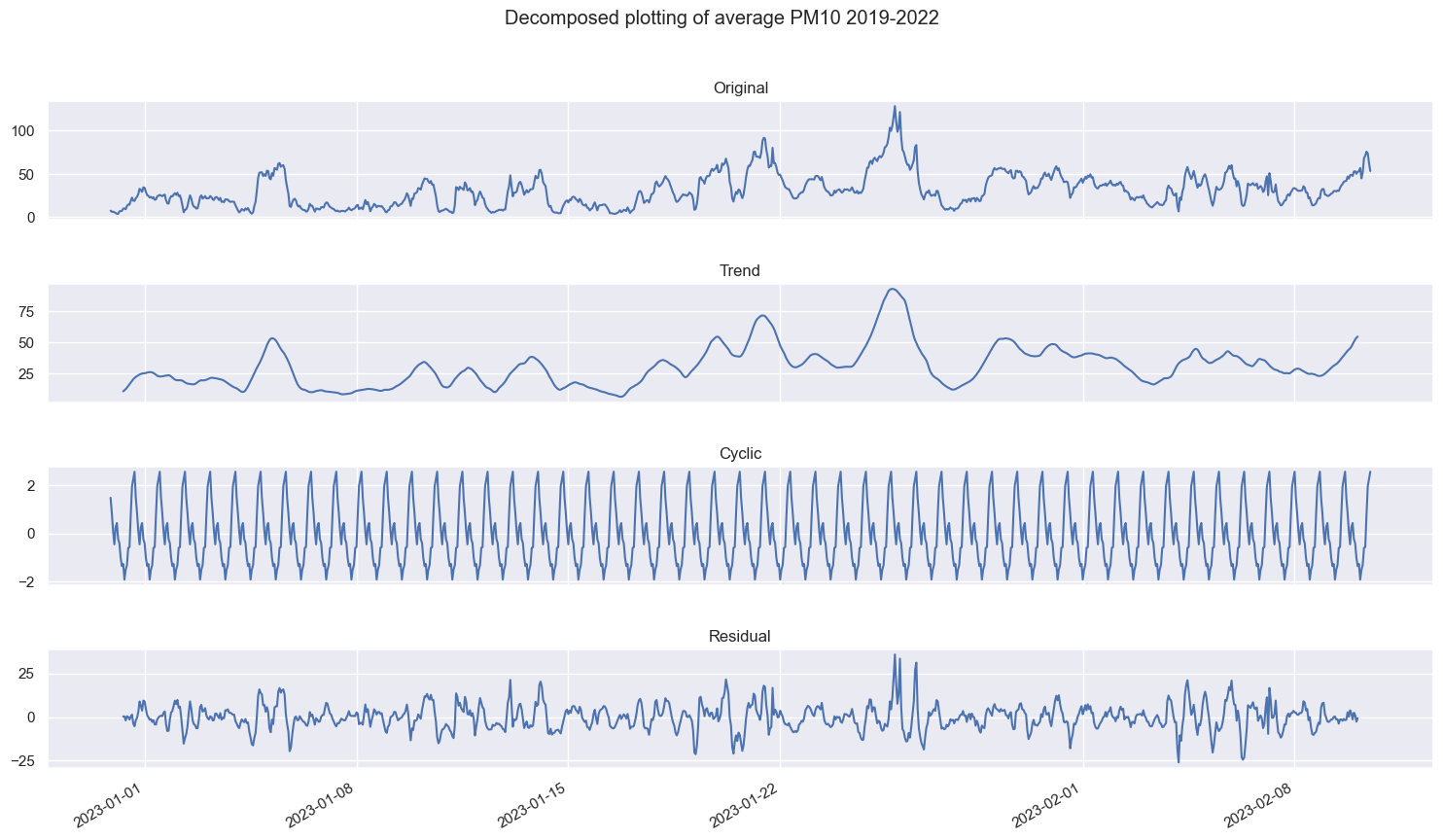
# PM10_202122 = series.PM10
train = series_PM10[0:int(len(series_PM10)*0.9)]
test = series_PM10[int(len(series_PM10)*0.9):]
y_hat_naive = pd.DataFrame(test)
y_hat_naive['naive_forecast'] = train[len(train) - 1]
fig = plt.figure(figsize=(20,5))
plt.grid()
plt.plot(train.index, train, label='Train')
plt.plot(test.index, test , label='Test')
plt.plot(y_hat_naive.index, y_hat_naive['naive_forecast'], label='Naive forecast')
plt.legend(loc='best')
plt.title('Naive Method')
plt.xticks(rotation=45)
plt.show()

rmse = sqrt(mean_squared_error(test, y_hat_naive['naive_forecast']))
print('Test RMSE: %.3f' % rmse)
mae = mean_absolute_error(test, y_hat_naive['naive_forecast'])
print('MAE: %.3f' % mae)
Test RMSE: 11.106
MAE: 9.327
df_testing = train.reset_index()
df_testing['unique_id'] = "PM10Data"
df_testing.rename(columns={'Datetime':'ds', 'PM10':'y'}, inplace = True)
df_testing.head(10)
sf = StatsForecast(
models = [SeasonalNaive(season_length = 24)],
freq = '60T'
)
sf.fit(df_testing)
days = test.index.unique()
test_days = test.groupby(test.index).mean()
y = df_testing['y'].to_numpy()
y_hat_dict = sf.predict(h=len(test_days))
y_hat_dict = y_hat_dict.reset_index()
y_hat_dict.index = y_hat_dict.ds
forecast_df = pd.DataFrame(y_hat_dict['SeasonalNaive'])
# plt.plot(train.index, train)
plt.plot(test.index,test)
plt.plot(forecast_df.index, forecast_df)
plt.xticks(rotation=45)
plt.show()
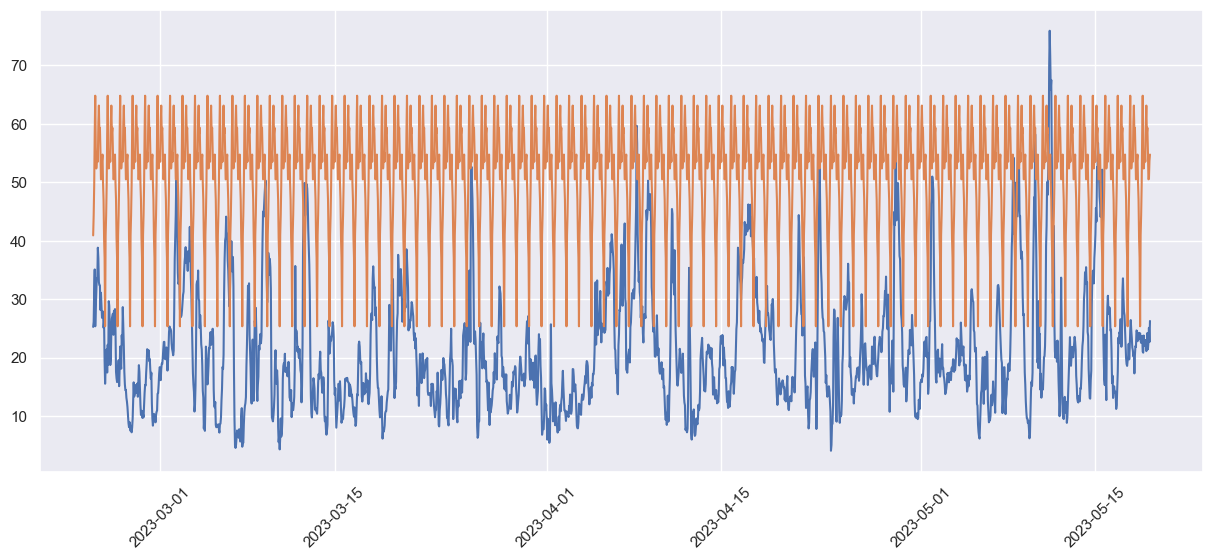
rmse = sqrt(mean_squared_error(test_days, forecast_df))
print('Test RMSE: %.3f' % rmse)
mae = mean_absolute_error(test_days, forecast_df)
print('MAE: %.3f' % mae)
Test RMSE: 32.623
MAE: 30.422
OBSERVATION
Chapter 6 - Seasonal ARIMA
zzzz
df_521_data.index
DatetimeIndex(['2021-01-21 13:00:00', '2021-01-21 13:10:00',
'2021-01-21 13:20:00', '2021-01-21 13:30:00',
'2021-01-21 13:40:00', '2021-01-21 13:50:00',
'2021-01-21 14:00:00', '2021-01-21 14:10:00',
'2021-01-21 14:20:00', '2021-01-21 14:30:00',
...
'2023-05-19 07:30:01', '2023-05-19 07:40:00',
'2023-05-19 07:50:00', '2023-05-19 08:00:00',
'2023-05-19 08:10:00', '2023-05-19 08:20:01',
'2023-05-19 08:30:00', '2023-05-19 08:40:00',
'2023-05-19 08:50:00', '2023-05-19 09:00:00'],
dtype='datetime64[ns]', name='Datetime', length=111871, freq=None)
sarima_df = df_521_data.copy()
sarima_df = sarima_df.resample('60min').mean().ffill().asfreq('60min')
sarima_df = sarima_df.PM10
train = sarima_df[0:int(len(sarima_df)*0.95)].asfreq('60T')
test = sarima_df[int(len(sarima_df)*0.95):].asfreq('60T')
# train = sarima_df[0:-1000].asfreq('60T')
# test = sarima_df[-100:].asfreq('60T')
mod = sm.tsa.statespace.SARIMAX(train,
order=(1,1,1),
seasonal_order=(1,1,1,24),
enforce_stationarity=False,
enforce_invertibility=False)
results = mod.fit(low_memory=True)
# pred = results.get_prediction(start = test.head().index[0], end= 100, dynamic=True)
pred = results.get_forecast(len(test))
pred_ci = pred.conf_int()
len(pred_ci)
1018
pred.predicted_mean
2023-04-07 00:00:00 37.037621
2023-04-07 01:00:00 37.326010
2023-04-07 02:00:00 37.309312
2023-04-07 03:00:00 36.760874
2023-04-07 04:00:00 36.717244
...
2023-05-19 05:00:00 39.125892
2023-05-19 06:00:00 39.230595
2023-05-19 07:00:00 39.475869
2023-05-19 08:00:00 39.222370
2023-05-19 09:00:00 38.787616
Freq: 60T, Name: predicted_mean, Length: 1018, dtype: float64
ax = test.plot(label='Real Data', figsize=(25, 10))
pred.predicted_mean.plot()
# ax.fill_between(pred_ci.index,
# pred_ci.iloc[:, 0],
# pred_ci.iloc[:, 1], color='k', alpha=.2)
plt.legend()
# plt.xlim(['2022-02-20', '2023-02-21'])
# plt.title("PM10 per 10 Minutes", fontsize=15)
plt.xlabel('Date Time combo per 60 Minutes')
plt.ylabel('PM10 (ug/m3)')
plt.show()
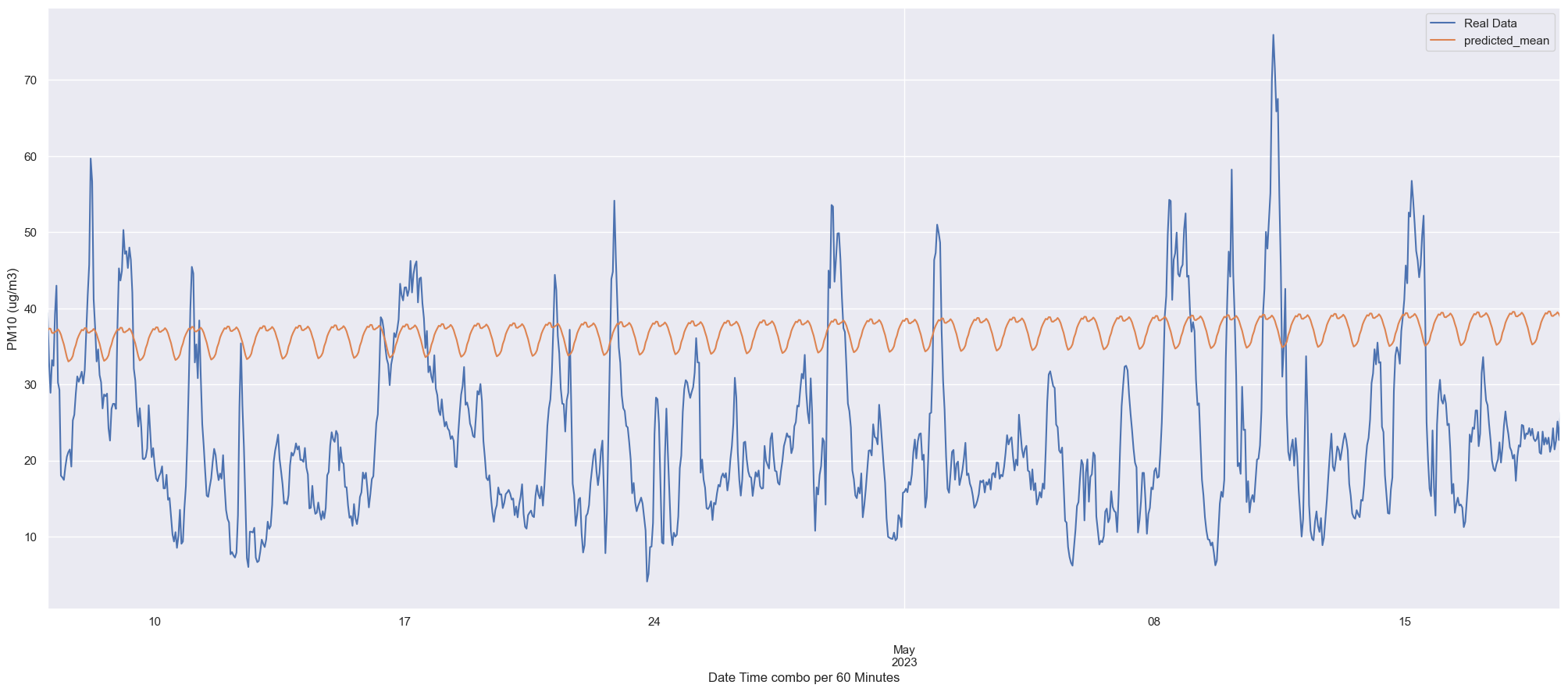
y_true = test.values
y_pred = pred.predicted_mean
mae = mean_absolute_error(y_true, y_pred)
rmse = sqrt(mean_squared_error(y_true, y_pred))
r2_train = r2_score(y_true, y_pred)
print('MAE: %.3f' % mae)
print('RMSE: %.3f' % rmse)
print('R2 score: {}'.format(r2_train))
MAE: 15.843
RMSE: 17.372
R2 score: -1.4834429241888407
Chapter 7 - Polynomial Features
for index in useable_data.index:
useable_data['DateTime'][index] = pd.to_datetime(useable_data['DateTime'][index]).timestamp()
useable_data
| DateTime | Location | PM10 | PM2.5 | PM1 | WindDir | WindSpeed_avg | PrecipationHour | Temp | |
|---|---|---|---|---|---|---|---|---|---|
| 0 | 1609459200.0 | 522 | 60.440000 | 51.553333 | 40.851667 | 290 | 10 | 0 | 20 |
| 1 | 1609459200.0 | 524 | 51.945000 | 44.296667 | 21.755000 | 290 | 10 | 0 | 20 |
| 2 | 1609459200.0 | 526 | 67.430000 | 60.678333 | 38.430000 | 290 | 10 | 0 | 20 |
| 3 | 1609459200.0 | 527 | 70.378333 | 62.808333 | 39.130000 | 290 | 10 | 0 | 20 |
| 4 | 1609459200.0 | 529 | 56.486667 | 51.555000 | 30.910000 | 290 | 10 | 0 | 20 |
| ... | ... | ... | ... | ... | ... | ... | ... | ... | ... |
| 892118 | 1684278000.0 | 572 | 14.198333 | 8.448333 | 5.388333 | 290 | 20 | 0 | 67 |
| 892119 | 1684278000.0 | 574 | 10.563333 | 4.800000 | 2.753333 | 290 | 20 | 0 | 67 |
| 892120 | 1684278000.0 | 575 | 10.540000 | 7.101667 | 4.821667 | 290 | 20 | 0 | 67 |
| 892121 | 1684278000.0 | 576 | 16.710000 | 5.246667 | 4.116667 | 290 | 20 | 0 | 67 |
| 892122 | 1684278000.0 | 577 | 9.560000 | 6.486667 | 4.405000 | 290 | 20 | 0 | 67 |
892123 rows × 9 columns
from sklearn.preprocessing import PolynomialFeatures
from sklearn.linear_model import LinearRegression
X_train = useable_data[:-24].drop(['PM10','PM2.5','PM1'], axis=1)
Y_train = useable_data[:-24]['PM10']
X_test = useable_data[-24:].drop(['PM10','PM2.5','PM1'], axis=1)
Y_test = useable_data[-24:]['PM10']
def create_polynomial_regression_model(degree):
"Creates a polynomial regression model for the given degree"
poly_features = PolynomialFeatures(degree=degree)
# transforms the existing features to higher degree features.
X_train_poly = poly_features.fit_transform(X_train)
# fit the transformed features to Linear Regression
poly_model = LinearRegression()
poly_model.fit(X_train_poly, Y_train)
# predicting on training data-set
y_train_predicted = poly_model.predict(X_train_poly)
# predicting on test data-set
y_test_predict = poly_model.predict(poly_features.fit_transform(X_test))
# evaluating the model on training dataset
rmse_train = np.sqrt(mean_squared_error(Y_train, y_train_predicted))
r2_train = r2_score(Y_train, y_train_predicted)
# evaluating the model on test dataset
rmse_test = np.sqrt(mean_squared_error(Y_test, y_test_predict))
r2_test = r2_score(Y_test, y_test_predict)
print("The model performance for the training set")
print("-------------------------------------------")
print("RMSE of training set is {}".format(rmse_train))
print("R2 score of training set is {}".format(r2_train))
print("\n")
print("The model performance for the test set")
print("-------------------------------------------")
print("RMSE of test set is {}".format(rmse_test))
print("R2 score of test set is {}".format(r2_test))
plt.plot(y_test_predict)
for i in range(3):
print("degree is: {}".format(i))
create_polynomial_regression_model(i)
plt.plot(Y_test.reset_index(drop=True))
plt.show()
degree is: 0
The model performance for the training set
-------------------------------------------
RMSE of training set is 14.46229192559551
R2 score of training set is 0.0
The model performance for the test set
-------------------------------------------
RMSE of test set is 5.993982502208196
R2 score of test set is -0.26582615618008254
degree is: 1
The model performance for the training set
-------------------------------------------
RMSE of training set is 14.07516622892575
R2 score of training set is 0.052819348524525744
The model performance for the test set
-------------------------------------------
RMSE of test set is 7.587458967938542
R2 score of test set is -1.0283170191605833
degree is: 2
The model performance for the training set
-------------------------------------------
RMSE of training set is 14.011162933271896
R2 score of training set is 0.061413897114652505
The model performance for the test set
-------------------------------------------
RMSE of test set is 7.45098038658431
R2 score of test set is -0.9560050160488545
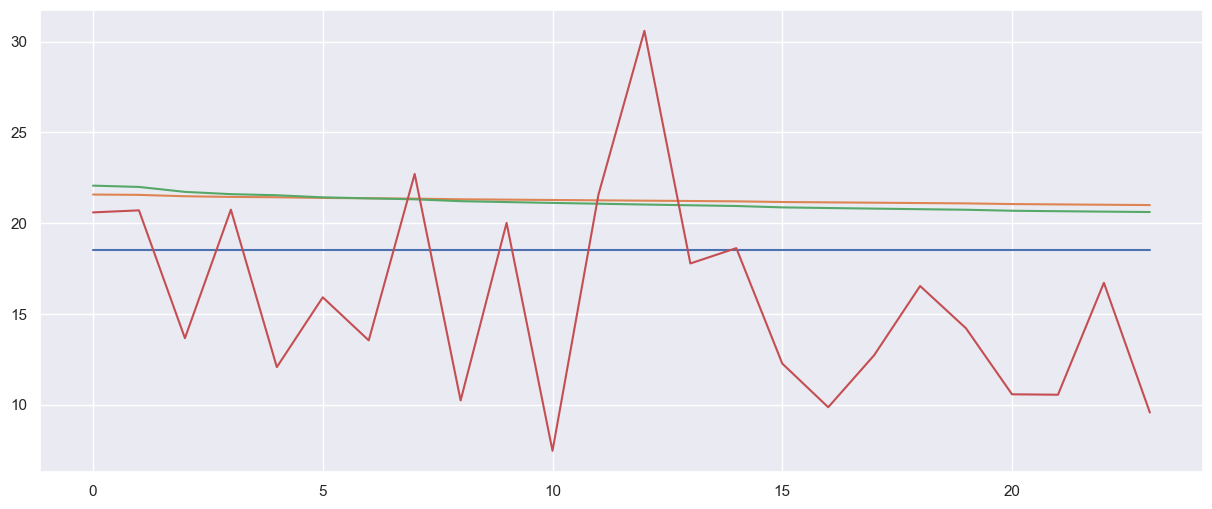
poly_features = PolynomialFeatures(degree=1)
# transforms the existing features to higher degree features.
X_train_poly = poly_features.fit_transform(X_train)
# fit the transformed features to Linear Regression
poly_model = LinearRegression()
poly_model.fit(X_train_poly, Y_train)
# predicting on training data-set
y_train_predicted = poly_model.predict(X_train_poly)
# predicting on test data-set
y_test_predict = poly_model.predict(poly_features.fit_transform(X_test))
plt.plot(y_test_predict)
plt.plot(Y_test.reset_index(drop=True))
plt.show()
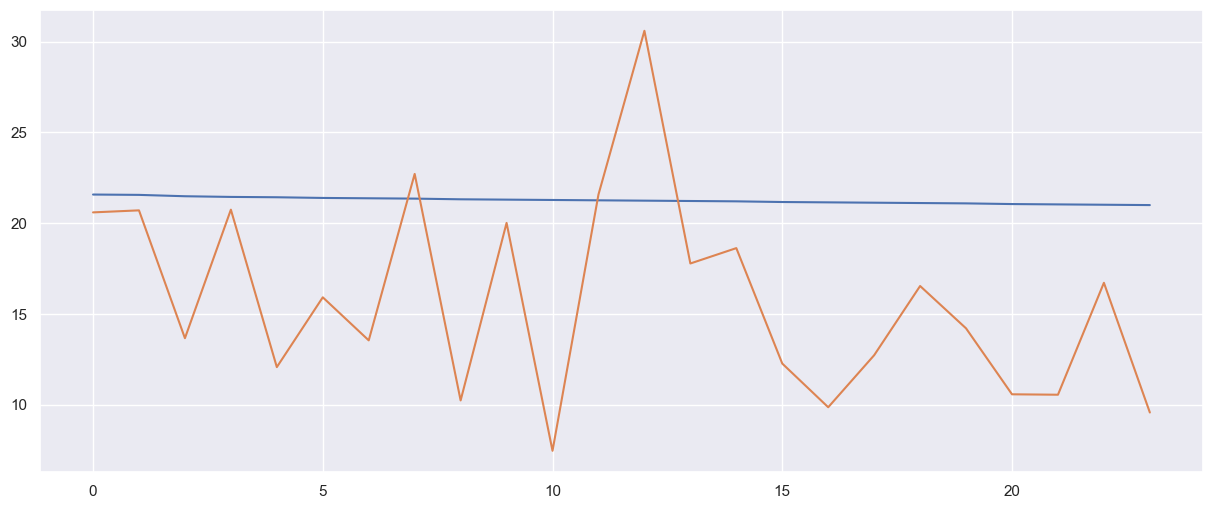
y_test_predict
array([21.57553263, 21.55679041, 21.48182152, 21.44433707, 21.42559485,
21.3881104 , 21.36936818, 21.35062596, 21.31314152, 21.29439929,
21.27565707, 21.25691485, 21.23817263, 21.2194304 , 21.20068818,
21.16320374, 21.14446151, 21.12571929, 21.10697707, 21.08823485,
21.0507504 , 21.03200818, 21.01326596, 20.99452374])
KNN for Locations
from sklearn.neighbors import KNeighborsClassifier
locations = pd.read_csv('csv_files/locaties-airboxen.csv', sep=';')
neigh = KNeighborsClassifier(n_neighbors=1)
neigh.fit(locations[['Lon','Lat']], locations['ID'])
KNeighborsClassifier(n_neighbors=1)In a Jupyter environment, please rerun this cell to show the HTML representation or trust the notebook.
On GitHub, the HTML representation is unable to render, please try loading this page with nbviewer.org.
KNeighborsClassifier(n_neighbors=1)
print(neigh.predict([[5.486614062741882,51.4460197870039]]))
[534]